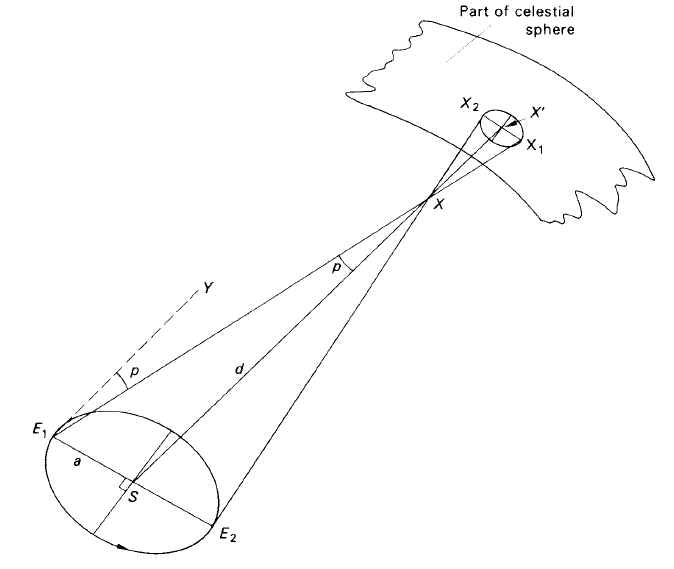
Stellar parallax: Stellar parallactic movements
 المؤلف:
A. Roy, D. Clarke
المؤلف:
A. Roy, D. Clarke
 المصدر:
Astronomy - Principles and Practice 4th ed
المصدر:
Astronomy - Principles and Practice 4th ed
 الجزء والصفحة:
p 126
الجزء والصفحة:
p 126
 1-8-2020
1-8-2020
 2247
2247
Stellar parallax: Stellar parallactic movements
The direction of a star as seen from the Earth is not the same as the direction when viewed by a hypothetical observer at the Sun’s centre. As the Earth moves in its yearly orbit round the Sun, the geocentric direction (the star’s position on a geocentric celestial sphere) changes and traces out what is termed the parallactic ellipse. Thus, in figure 1, the star X at a distance d kilometres is seen from the Earth at E1 to lie in the direction E1X1 relative to the heliocentric direction SX'. Six months later, the Earth is now at the point E2 in its orbit and the geocentric direction of the star is E2X2.
The concepts used in stellar parallax are analogous to those used in geocentric parallax. Thus, if we looked upon the Earth’s orbital radius a as the base-line, we can define the star’s parallax as P, given by
 .........(1)
.........(1)
Because stellar distances are so great compared with the Earth’s orbital radius, we can assume that the Earth’s orbit to be circular. Angle P is small so that we can write equation (1) as

where P is in seconds of arc.
Again, if we draw E1Y parallel to SX in figure 1. and let ∠Y E1X = ∠E1XS = p, we have, from ΔE1XS,

or


Figure 1. The parallactic ellipse (the size is exaggerated for clarity).
Using equation (1) and letting ∠XE1S = θ, we obtain
sin p = sin P sin θ
or
p = P sin θ (2)
since both p and P are small angles.
Thus, the star is displaced towards the Sun along the great circle through the star’s heliocentric position and the Sun by an amount p, given by equation (2), where P is the star’s parallax and θ is the angle between the Sun’s direction and the star’s. Whereas P remains constant, p and θ vary because of the Earth’s movement in its orbit about the Sun.
 الاكثر قراءة في مواضيع عامة في علم الفلك
الاكثر قراءة في مواضيع عامة في علم الفلك
 اخر الاخبار
اخر الاخبار
اخبار العتبة العباسية المقدسة


